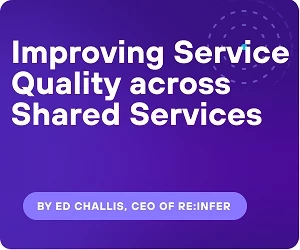
Shared services continue to battle heavy workloads, high attrition, and lackluster productivity. Greater automation could help to ease the pressure on overworked agents and boost capacity. Yet there are signs that traditional automation tools are starting to run out of road. The low-hanging fruit is mostly gone, and they won’t be able to automate the complex, communications-based processes that remain.
Fortunately, more advanced AI and conversational analytics provides a way. Service leaders should consider how recent developments in natural language processing (NLP) can be used to boost productivity - not just by hitting their targets but going beyond to create real business value.
Here are three rapid use cases where AI is used to enhance shared services productivity:
1. Automation discovery
Automation is one of the most powerful tools in the shared services toolbox. According to Deloitte, nearly three-quarters (72%) of shared services leaders have already deployed automation in their organisation, achieving impressive cost savings in the process. Tools like robotic process automation (RPA), workflow and business process management solutions free agents from many mundane, repetitive processes. Yet there’s a whole category of tasks these tools can’t touch.
The most important but costly processes in the enterprise often go unmeasured. Service interactions between agents and clients - whether that’s making a call or sending an email - are pervasive and crucial to any shared services function. But they monopolise agent time and not all generate real value for the business. Many tasks are purely transactional, critical to work but forgotten by customers almost immediately. They’re perfect opportunities for automation.
The challenge is finding them. Interactions between people in a business increasingly take place on digital channels and are expressed in natural human language. This isn’t data you can just plug into an analytics tool. Process analysis solutions like Process Mining can show you where a process has broken down, but they won’t be able to tell you why.
The most damaging issues, the most ideal opportunities for process improvement and automation, remain hidden under masses of unstructured conversational data. Service leaders have tried to extract this information manually, but it’s never scalable. Stakeholder interviews, manual call logging - these only distract agents from their work and produce insights that are subjective and unreliable.
Communications Mining is an ideal discovery tool for these unstructured processes. Using the latest advances in NLP, Communications Mining reliably extracts the most important information from business conversations - at speed and scale. The highest-volume issues and drivers of demand, the requests that require the most effort from agents and clients - these are rapidly identifiable with Communications Mining. And once a costly process has been identified, it can be analysed and judged for automation or elimination.
2. Automating requests from end to end
Communications Mining doesn’t just identify processes for improvement. It creates clean structured data that helps spread automation across shared services - and into entirely new workflows.
Many of the most common and therefore time-consuming service requests are purely transactional. That is to say they require only a handful of contacts or actions from agents to be completed. Examples include changing a client’s password or responding to an FAQ. Indeed, it’s estimated that at least half of all requests that come into a service centre are transactional in nature.
Yet that doesn’t mean they are easy to automate. An RPA bot could be programmed to process an email a certain way, but it will never understand its contents. The understanding and comprehension of natural, human language is still essential for completing even transactional requests. But, thanks to recent advances in NLP, human intelligence is no longer required.
The latest NLP models consistently outperform human agents in both language understanding and reading comprehension. Communications Mining tools can reliably interpret and understand business conversations - whether on the phone, in chat or email - and extract the most important information as structured data. This data can then be sent downstream to automation tools, such as RPA, to complete the request.
What we have in practice is the end-to-end automation of transactional service requests. Much of the most inefficient and costly demand that enters your service function can be processed with zero human input. This frees agents to focus on more complex requests, it shortens response times and enhances the client experience. Furthermore, automation helps to standardise many processes under a common framework, meaning it’s easier and faster to scale as your business grows.
3. Workflow management and allocation
Internal business processes are often as - if not more - inefficient than customer-facing ones. In many service functions, agents spend precious time manually filtering and categorising inbound demand for the right team. One Re:infer customer discovered that 97% of work was incorrectly routed the first time, forcing its skilled and highly-paid employees to manually triage requests to the right place.
Some popular case management platforms offer NLP capabilities to help streamline workflow management. But the reality is that such capabilities are very rudimentary, extracting only the most top-level information from requests - such as customer numbers and email subject lines. Without natural language understanding capabilities, agents still waste precious time manually routing and logging in the workflow system.
Fortunately, Communications Mining accurately extracts the most important information for workflow. When integrated with a workflow management system, Communications Mining enables reliable auto-triage and routing. Requests are sent to the right team or agent the first time, every time. Superior workflow orchestration enables faster resolution, more satisfied customers and less distracted agents.























